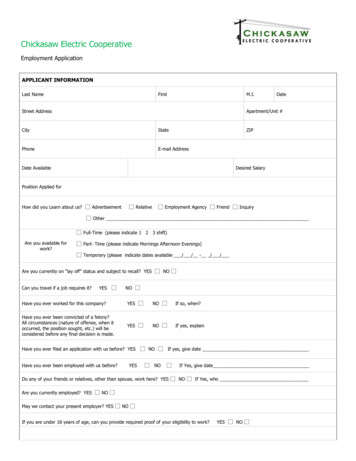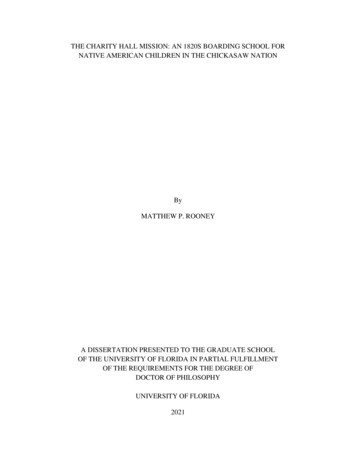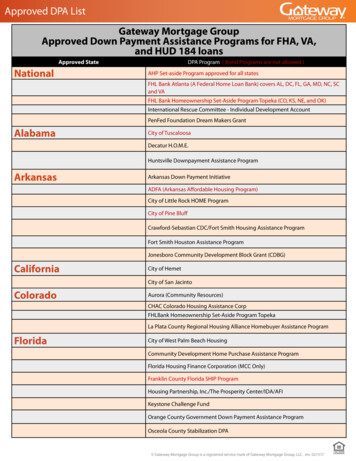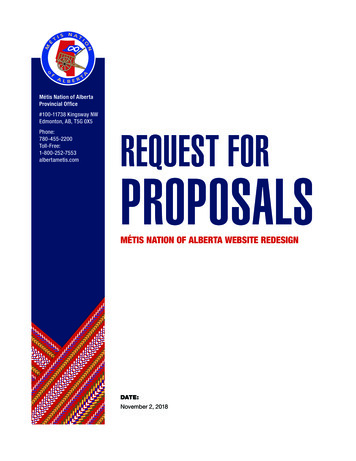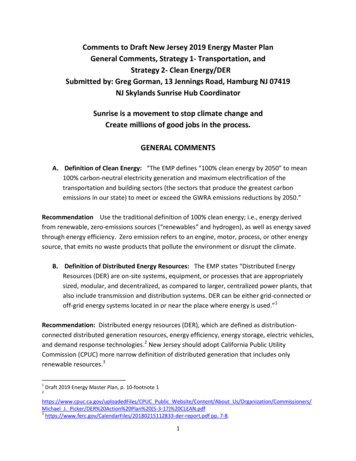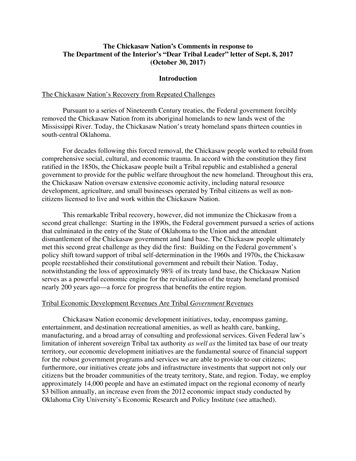
Transcription
The Chickasaw Nation’s Comments in response toThe Department of the Interior’s “Dear Tribal Leader” letter of Sept. 8, 2017(October 30, 2017)IntroductionThe Chickasaw Nation’s Recovery from Repeated ChallengesPursuant to a series of Nineteenth Century treaties, the Federal government forciblyremoved the Chickasaw Nation from its aboriginal homelands to new lands west of theMississippi River. Today, the Chickasaw Nation’s treaty homeland spans thirteen counties insouth-central Oklahoma.For decades following this forced removal, the Chickasaw people worked to rebuild fromcomprehensive social, cultural, and economic trauma. In accord with the constitution they firstratified in the 1850s, the Chickasaw people built a Tribal republic and established a generalgovernment to provide for the public welfare throughout the new homeland. Throughout this era,the Chickasaw Nation oversaw extensive economic activity, including natural resourcedevelopment, agriculture, and small businesses operated by Tribal citizens as well as noncitizens licensed to live and work within the Chickasaw Nation.This remarkable Tribal recovery, however, did not immunize the Chickasaw from asecond great challenge: Starting in the 1890s, the Federal government pursued a series of actionsthat culminated in the entry of the State of Oklahoma to the Union and the attendantdismantlement of the Chickasaw government and land base. The Chickasaw people ultimatelymet this second great challenge as they did the first: Building on the Federal government’spolicy shift toward support of tribal self-determination in the 1960s and 1970s, the Chickasawpeople reestablished their constitutional government and rebuilt their Nation. Today,notwithstanding the loss of approximately 98% of its treaty land base, the Chickasaw Nationserves as a powerful economic engine for the revitalization of the treaty homeland promisednearly 200 years ago—a force for progress that benefits the entire region.Tribal Economic Development Revenues Are Tribal Government RevenuesChickasaw Nation economic development initiatives, today, encompass gaming,entertainment, and destination recreational amenities, as well as health care, banking,manufacturing, and a broad array of consulting and professional services. Given Federal law’slimitation of inherent sovereign Tribal tax authority as well as the limited tax base of our treatyterritory, our economic development initiatives are the fundamental source of financial supportfor the robust government programs and services we are able to provide to our citizens;furthermore, our initiatives create jobs and infrastructure investments that support not only ourcitizens but the broader communities of the treaty territory, State, and region. Today, we employapproximately 14,000 people and have an estimated impact on the regional economy of nearly 3 billion annually, an increase even from the 2012 economic impact study conducted byOklahoma City University’s Economic Research and Policy Institute (see attached).
Chickasaw NationPage 2 of 5October 30, 2017These activities, whether conducted by the Tribe alone or with non-Tribal partners, aresubject to Chickasaw Nation oversight, through either the Chickasaw Nation ExecutiveDepartment or other Tribal agencies or commissions. While we have intergovernmentalcompacts with the State of Oklahoma that apply to much of these activities, periodicuncompacted intrusions by State and local regulatory or tax authorities can disrupt and chilldevelopment initiatives or otherwise siphon energies toward dispute resolution and management.Support for Modernization of the Indian Trader RegulationsGuiding Principles for ModernizationWe would welcome and support an administrative effort to modernize the Indian Traderregulations in a manner that supports tribal self-government and self-determination. Above all,we believe an appropriate modernization effort would— affirm Tribal rights as the primary regulators of Indian country initiativesthat occur either in partnership with or under the auspices of tribalgovernment; and protect Tribal rights to pursue Indian country economic developmentwithout regulatory or taxation intrusion by State or local governments.Furthermore, consistent with central principles of Federal Indian law, we believe an appropriatemodernization effort would— declare and affirm the Department’s commitment to parity in thetreatment of Tribal governments—namely, by shielding Tribalgovernment actors from the administrative application of Federalregulatory systems developed for oversight of private actors, not Tribal orother government actors.With respect to the parity principle, please note the Chickasaw Nation’s treaties with the UnitedStates include specific protections from unauthorized regulatory trespass on sovereign rights toTribal self-government. We have successfully asserted those rights to preempt, for example,regulatory trespass under the National Labor Relations Act. E.g., Chickasaw Nation d/b/aWinstar World Casino and International Brotherhood of Teamsters Local 886, Cases 17-CA025031 and 17-CA-025121 (attached). However, even a final victory remains only a partial one,since our obtaining it required a substantial defensive investment of time, money, and leadershipfocus—which resources could have otherwise been invested in progressive initiatives thatbrought tangible and material benefits to our citizens, our communities, and our broadereconomy.We believe a modernization initiative built on these principles would boost Indiancountry economic development and bring jobs and investment to some of the poorest regions ofthe United States.
Chickasaw NationPage 3 of 5October 30, 2017Specific RecommendationsIf the Department moves forward with its Indian Trader regulation modernization effort,we would recommend incorporation of the following specific elements—1. Delegate to Tribal governments the Federal law authority to license persons,companies, or other commercial entities doing business with Tribes or theircitizens within Indian countryThe greatest leap forward in a sustainable Federal Indian policy stemmed from thegovernment’s embrace of Tribal self-determination during the Nixon-era. Congress’s enactmentof the Indian Self-Determination and Education Assistance Act provided principles andframework for the empowerment of Tribal peoples to administer Federal programs and paved theway for an end to the paternalism and stifling control of prior policy eras. In any effort tomodernize the Indian Trader regulations, the Department should adhere to the self-determinationpolicy and work to empower Tribes to play the primary regulatory role. For example, updatedIndian Trader regulations should either delegate or defer to or otherwise incorporate Tribalregulatory oversight of persons, businesses, or other entities engaged in Indian countryeconomic development. Tribes will be in the best position to determine who is or who is notappropriate for doing business within their own communities and jurisdiction and will also bebest positioned for the most responsive and least intrusive regulatory oversight.2. Preempt State or local taxation or regulatory intrusion on Indian countryeconomic development conducted by Tribal governments or otherwise under theauspices of Tribal governmentsThe Supreme Court’s decisions in Warren Trading Post Co. v. Arizona State TaxCommission, 380 U.S. 685 (1965), and Central Machinery Co. v. Arizona State Tax Commission,448 U.S. 160 (1980), correctly recognized the Federal interest in Indian country economicactivity preempts State and local taxation and regulatory jurisdiction. Likewise, the SupremeCourt has recognized the preemptive effect of Tribal rights and interests in self-government.E.g., Williams v. Lee, 358 U.S. 217 (1959), a principle Congress incorporated to the IndianGaming Regulatory Act, 25 U.S.C. § 2701, et seq., when it expressly affirmed the relationshipbetween Tribal self-government and Tribal economic activity.Such law notwithstanding, Tribes must continually seek to stem ever-more creativeefforts by State and local authorities to tax or control Indian country activities. E.g., CottonPetroleum Corp. v. New Mexico, 480 U.S. 163 (1989) (allowing imposition of State severancetax on oil and gas produced by non-Tribal company from Tribal reservation lands,notwithstanding lawful imposition of a Tribal tax on same on-reservation activity);Mashantucket Pequot Tribe v. Town of Ledyard, 722 F.3d 457 (2nd Cir. 2013) (holdingmunicipality may levy personal property tax on machines operated by Tribe as part of its IGRAgaming activity but which are owned by non-Tribal company). Tribal litigation losses in theseinstances contributed to an ever more complex set of precedent that chills Indian countryeconomic activity, burdening such activity with dual taxation and potentially dual oversight
Chickasaw NationPage 4 of 5October 30, 2017obligations. Even when Tribes prevail, such litigations again contribute to the investment ofresources in conflict, not growth and progress.Modernization of the Indian Trader regulations provides the opportunity to bring clarityand “bright lines” back to this area of the law. We would advocate, accordingly, that updatedIndian Trader regulations should provide for an express preemption of inconsistent State andlocal taxation or regulatory jurisdiction. Such preemptive scope should apply, at minimum, toeconomic development activity conducted (a) by a Tribe or by a person, business, or other entitysubject to licensure by the Tribe; and (b) on land owned by the Tribe within treaty or reservationboundaries, by an American Indian subject to restrictions against alienation, or by the UnitedStates for the benefit of the Tribe or citizen or member of the Tribe.3. Preempt Federal regulatory intrusion on Tribal government activities unlesspursuant to a state Congress expressly intended to apply to Tribal governmentsConfusion has long complicated whether Tribal governments are subject to federalstatutes of “general applicability.” Many general federal statutes apply, by their specific terms, toTribal governments; others, however, are silent on the question. Where statutes are silent, thecommon law has failed to provide a uniform rule: On one hand, principles of Federal Indian lawhold that Tribal sovereign rights cannot be set aside without Congress’s expressly so providing,which puts the burden on Federal regulators; on the other hand, courts have held Tribal actors aresubject to Federal laws unless application of the law would be inconsistent with Tribal sovereignrights, which puts the burden on the Tribe. The Chickasaw Nation’s most recent engagement inthis fight involved the National Labor Relations Act, but other Tribal governments are presentlyengaged in litigation regarding jurisdiction of the Consumer Financial Protection Bureau. Wherestatutory silence gives rise to conflict over the scope and effect of Federal regulatory jurisdiction,Tribal sovereignty is injured and Indian country economic activity is stifled.As an exercise of its fiduciary responsibilities to American Indian tribes and in support ofstable economic development in Indian country, the Indian Trader regulations should be updatedto affirm the Department’s position that Tribal government economic development activity isnot subject to Federal regulatory jurisdiction unless the statute under which such jurisdictionis asserted expressly so provides. Such position can be well supported by the law and wouldprovide Congress with “bright line” guidance that would be conducive to regulatory stability inIndian country.ConclusionAmerican Indian Tribes operating with the United States look to Federal law to affirmour rights to self-government and self-determination. In that spirit, we look to the Federal trusteefor help in ensuring we can pursue economic development without tax and regulatory intrusionsthat serve ends other than strengthening Tribal self-government, self-determination, and selfsufficiency. Under the Indian Trader regulatory system, the Federal trustee formerly wielded astrong hand in regulating Indian country economic activity; we have no desire for the trustee toreturn to that sort of paternalistic role, but we would welcome the exercise of clear Federal
Chickasaw NationPage 5 of 5October 30, 2017authority to preempt unnecessary taxation or regulatory interference in Tribal economicdevelopment throughout Indian country.If the Department proceeds, we would look forward to providing substantive engagementin accord with the principles and issues outlined in these comments.
Steven C. AgeeEconomic Research & Policy InstituteEstimating the Oklahoma Economic Impact of theChickasaw NationMay 15, 2012Economic Research & Policy InstituteOklahoma City University2501 N. BlackwelderOklahoma City. OK 731116
2011 Chickasaw Nation Economic Impact AnalysisExecutive SummaryThe Chickasaw Nation is headquartered in Ada, Oklahoma and encompasses 7,648 square miles over13 counties in south-central Oklahoma. According to the 2010 Census, there are just over 52,000Chickasaw citizens throughout the United States'. Of the total population, tribal roles indicate that31,326 reside in Oklahoma.Tribal operations within the state consist of primarily government provision of services, operations oftribal-owned gaming centers and banks. The Economic Research and Policy Institute reviewed theexpenditures and revenues of the Chickasaw Nation and the current production structure of the stateeconomy to estimate the total contribution of tribal activities to the state. Among the key findings ofthis report are: The Nation employed 11,030 individuals nationwide in2011of which 10,015 were employed inOklahoma. The Nation made direct payroll contributions of 318 million to Oklahoma residents, or 31,731per employee'. The Nation made direct payments of 119 million to Oklahoma entities in pursuit of medicalcare access, educational advancement, social services and economic development opportunities for Oklahoma residents and Chickasaw Nation citizens. Total government expenditureswere 129 million. Chickasaw Nation business operations in Oklahoma, including gaming, banking and other retail generated 1.39 Billion in revenues - a significant source of economic output within thestate. When analyzed in the context of the Oklahoma economy and accounting for spillover (multiplier) impacts, we estimate that these activities supported:o 15,958 jobs in the stateo 525 million in state incomeo 2.43 billion in state production of goods and services' See 2010 Census Brief: "The American Indian and Alaska Native Population: 2010," issued January 2012.Pay per employee is likely understated as some employees reside outside Oklahoma while working within the state. Payroll to2these employees is considered a leakage while their employment within the state is included in reported employment numbers.2
2011 Chickasaw Nation Economic Impact AnalysisIntroductionIn2011,the Oklahoma Department of Commerce, along with several Native AmericanTribes commissioned a study to estimate the Oklahoma statewide economic impact of all NativeAmerican operations. The Economic Research and Policy Institute (ERPI) at Oklahoma City University, in cooperation with our tribal partners, will complete the final study in the spring of2012.As a participant in the study, each tribe received a short description of their tribal specific impacts. This document outlines the impacts of the Chickasaw Nation.Headquartered in Ada Oklahoma,the Chickasaw Nation encompasses portionsof 13 counties in south central Oklahomaand has additional operations in New Mexico, Georgia and Texas. The Chickasaws wererelocated to Oklahoma (Indian Territory)from parts of Kentucky, Tennessee, Mississippi and Alabama in the mid i800s alongwith the Cherokees, Choctaws, Creeks and1.--,Seminoles. The Treaty of Doaksville calledfor their resettlement among the Choctawtribe in 1837. Since 1856 when the Chicka-Chickasaw Nationsaws separated from the Choctaws, theyhave managed their own governmental and business affairs.Tribal operations of the Chickasaw Nation are classified into two broad categories: Business and Government Operations. While the Nation has offices in four states, the economic impact estimates within this report detail the Oklahoma specific impacts and therefore do not include any national or regional impacts occurring outside the state. Chickasaw Nation activitiesare summarized in Table 1.3
2011 Chickasaw Nation Economic Impact AnalysisTable 1: Chickasaw Nation Statewide Summary Information - 2011Government Operations Business Operations7,270Employment2 ,745 185,889,437 131,898,375Payroll 1,386,497,117Revenues 128,520,357Gov't Expenditures 7,286,958Federal Road ExpendituresTotal10,015 317,787,812 1,386,497,117 128,520,357 balacNote: All numbers reflect Oklahomativity is not included in this analysis.Business ActivitiesIn2011,the Nation received 1.39 billion in combined revenues from its Oklahoma operat-ed business entities of which gaming accounted for 91.5% of the total. The Nation businesses employed 7,270 full and part time workers with a combined payroll of 186 million. CN business datais detailed in Table2.Table 2: CN Business SummaryBankingGaming and OtherProfessional ServicesRevenues 12,472,661 1,269,119,403 104,905,053Total 1,386,497,117Payroll 3,110,095Employment 175, 819,949 6,959,393 185,889,437486 ,5346887,270CN operated 17 gaming centers in south central Oklahoma including two of the largest inthe state in the Winstar World Casino in Thackerville and the Riverwind Casino in Norman in2011.Gaming operations accounted for 1.27 billion in direct revenues in 2011. Additionally, gam-ing operations provided 6,534 jobs and paid 176 million in payroll and benefits in2011.In addition to gaming, the Nation was involved in Banking and Professional Services.Chickasaw Banc Holding Company operated Bankin Oklahoma City, which had revenues of2over 12 million, provided 48 jobs and directed over 3 million in payroll to bank employees.Chickasaw Nation Industries (CNI) provided professional services for a variety of external clientsincluding federal and state governmental entities. In2011,over 105 million in revenue from statewide operations.4CNI maintained 688 jobs and received
2011 Chickasaw Nation Economic Impact AnalysisChickasaw Nation GovernmentTo maintain consistency across all tribal reports, we classified all government activities into Education, Medical, Social Services, Economic Development and General Operations categories. According to the Nation, Medical Services consumed the largest share of their total government budget in2011with expenditures totaling more than 57 million or 44%. Economic Devel-opment activities included all capital improvements and followed medical expenditures with 26million in2011.Government activities accounted for 2,745 employees paying out 132 million inpayroll. Government data is summarized in Table 3.Table 3: CN Government SummaryEducationMedicalSocial ServicesEconomic DevelopmentGeneral OperationsTotalExpenditures 9,377,422 57,010,216 19,162,062 25,723,108 17,247,549Payroll 9,623,897 58,508,668 19,665,716 26,399,212 17,700,882 128,520,357 131,898,375Employment2001,2184095493682,745In addition to normal governmental activity, the Chickasaw Nation obtained and providedfederal funding to the state for road and bridge projects within their tribal boundaries. In cooperation with the Oklahoma Department of Transportation, the nation participated in 7,286,958worth of road improvements to infrastructure used by all Oklahomans. These additional moniesprovided external funding to improve infrastructure that otherwise would have been funded byOklahoma taxpayers.Impact MethodologyThe methodology employed in this report is designed to estimate the contribution of anexisting industry to the local economy.3 The approach begins with a static description of expenditure flows between households and industries, capturing the reliance of one industry's output on other, supporting industries. For example, by examining the expenditures from the construction industry to the wholesale lumber industry we can derive an estimate of the reliance ofthe construction sector on wholesale lumber output. From these frozen-in-time expenditureIn fact, while reports of this nature are commonly referred to as 'impact analysis', they are more correctly characterizedas 'contribution analyses.35
2011 Chickasaw Nation Economic Impact Analysisflows, we can derive economic multipliers specific to each industry. These multipliers estimatethe combined, or total economic impact originating from an initial expenditure. In the context ofthis report, for example, the gaming and recreation output multiplier estimates the total impactto economic output stemming from an initial output change within the gaming sector. Similarly,multipliers for employment and income are derived and interpreted. This approach is valuableas it provides rich information at a relatively low computational cost. However, the methodologydoes invoke some restrictive assumptions, including constant prices and a fixed production process, and should not be confused with a computationally higher cost economic forecast.Economic ImpactsEconomic impacts are estimated for three categories: output (total production within aregion; total revenue serves as a proxy for output), income, and employment (full-time equivalent). Data was provided by the Chickasaw Nation, analyzed in conjunction with publically available data from the Bureau of Economic Analysis, and impacts estimated using Implan multipliersfor the state of Oklahoma. 4 All impacts include both the direct impacts from CN operations, multiplier impacts, and sum giving total impacts. For example, CN revenues from business operations combined with expenditures from in-state government operations and community development are estimated to have generated nearly 1.52 billion in output (this is the Nation's directcontribution to the local economy), and an additional 909 million in spillover production (theoutput of non-CN firms who directly or indirectly support CN operations), combining to generate 2.43 billion in local economic output. All other impacts are interpreted analogously. Table4provides the impact estimates. More detailed impact tables are provided in the appendix to thisdocument.Table 4: Chickasaw Nation Statewide Impacts - 2011Direct Impacts Multiplier Impacts Total ImpactsOutputPayrollEmployment 1,522,304,432 317,787,812 909,483,659 206,849,817 2,431,788,091 524,637,62910,015.0o5,942 .771 5,957.77Implan is a national vendor of economic multipliers. Refer to the Minnesota Implan Group and www.implan.com foradditional information. When necessary, multipliers are adjusted to reflect local knowledge of economic conditions.46
2011 Chickasaw Nation Economic Impact AnalysisConclusionThe Chickasaw Nation continues to be a source of economic activity in south central Oklahoma. The contributions analysis performed suggests the CN activities sustain 15,958 jobs, generating 525 million in payroll income, and over 2.43 billion in Oklahoma production of goodsand services. All impact estimates provided in this report fail to include productivity gains originating with the provision of essential government services, as well as the significant economic andnon-economic impacts stemming from CN philanthropic efforts. The Chickasaw Nation is andwill continue to be a significant economic presence in the region.7
2011 Chickasaw Nation Economic Impact AnalysisAppendix: Impact TablesTable 5: Chickasaw Nation Impacts - 2011DirectMultiplier EffectOutputEducation ServicesMedical ServicesSocial ServicesEconomic DevelopmentGovernment OperationsGaming and OtherBankingProfessional ServicesFederal Road ProjectsTotal Output ImpactsEmploymentGovernmentBusinessTotal Employment ImpactsPayrollGovernmentBusinessTotal Payroll ImpactsTotal 9,377,4 22 57,010,216 19,162,062 25,723,108 17,247,549 1, 269,11 9,403 12,472,661 104,905,053 7,286,958 41, 981, 06 5 15,212,686 98,991,281 14,833,659 22,271,171 14,932,998 717,620,846 8,578,811 77,928,612 5,501,234 33,995,721 47,994, 279 32,180,547 1,986,740,249 21,051,472 182,833,665 12,788,192 1,522 30 4,432 909 483,659 .4910,546.2810,015.005,942 .771 5,957.77 131 , 8 98,375 185,889,437 86,423,948 120,425,869 218,322,323 306,315,306 317,787,812 206,849,817 524,637,6298 5,835,264,
2011 Chickasaw Nation Economic Impact AnalysisTable 6: Chickasaw Nation Impacts (Output/Production)IndirectDirectTotalGovernment 9,377,4 22 57,010,216 19,162,062 25,723,108EducationMedicalSocial ServicesEconomic DevelopmentGovernment OperationsFederal Road ProjectsTotal Government 17, 247,549 7,286,958 135,807,315 5,835,264 41,981,065 14,833,659 22,271,171 14,932,998 5,501,234 105,355,390 15,212,686 98,991,281 33,995,721 47,994, 279 32,180,547 12,788,192 241,162,705Business OperationsGaming and OtherBankingProfessional ServicesTotal BusinessTotal Output Impacts 1,98 6 , 740 ,249 1,386,4 97,117 717,620,846 8,578,811 77,928,612 804,128,269 1,522,304,432 909,483,659 2,431,788,091 1,269,119,403 12,472,661 104,905,053 24051,472 182,833,665 2,190,625,386Table 7: Chickasaw Nation Impacts (Employment)Direct Multiplier EffectTotalGovernmentEducationMedicalSocial ServicesEconomic Development200.291,217.65409.27Government 07.42883.171,432.58368.38592.18960.56Total Government2 ,7452,6665,411Gaming and OtherBanking6,534486887,2702 siness OperationsProfessional ServicesTotal BusinessTotal Employment Impacts993
2011 Chickasaw Nation Economic Impact AnalysisTable 8: Chickasaw Nation Impacts (Payroll)DirectMultiplier EffectTotalGovernmentEducationMedicalSocial ServicesEconomic DevelopmentGovernment OperationsTotal Government 9,623,897 58,508,668 19,665,716 26,399,212 17,700,882 131,898,375Gaming and OtherBankingProfessional ServicesTotal Business 175,819,949 3,110,095 3,880,005 23,706,627 8,586,638 30,081,077 20,169,602 13 ,503 ,90 2 82,215,295 28,252,354 56,480,289 86,423,948 37,870,484 218,322,323 6,959,393 185,889,437 112 ,995,746 4,265,913 3,164,210 120,425,869 288,815,695 7,376,008 10,123,603 306,315,306 317,787,812 2 0 6, 84 9,8 17 5 24,637,629Business OperationsTotal Payroll Impacts10
NOTICE: This opinion is subject to formal revision before publication in thebound volumes of NLRB decisions. Readers are requested to notify the Executive Secretary, National Labor Relations Board, Washington, D.C.20570, of any typographical or other formal errors so that corrections canbe included in the bound volumes.Chickasaw Nation d/b/a Winstar World Casino andInternational Brotherhood of Teamsters Local886, affiliated with The International Brotherhood of Teamsters. Cases 17–CA–025031 and17–CA–025121June 4, 2015DECISION AND ORDERBY MEMBERS MISCIMARRA, HIROZAWA,AND MCFERRANAt issue in this case is whether an Indian tribe, theChickasaw Nation, in its capacity as operator of theWinStar World Casino, is subject to the Board’s jurisdiction and, if so, whether it violated Section 8(a)(1) of theNational Labor Relations Act by informing casino employees that because of the Nation’s tribal sovereignty,they did not have the protection of the Act. Applying thetest established by the Board in San Manuel Indian Bingo & Casino, 341 NLRB 1055 (2004), enfd. 475 F.3d1306 (D.C. Cir. 2007), we find that application of the Actwould abrogate treaty rights, specific to the Nation, contained in the 1830 Treaty of Dancing Rabbit Creek. As aresult, we decline to assert jurisdiction over the Nation,the Respondent here.I. BACKGROUNDOn September 5, 2012, the Board issued an unpublished Order granting a joint motion to approve astipulation of facts agreed to by the General Counsel, theRespondent, and the Charging Party, and to transfer thisproceeding to the Board for issuance of a Decision andOrder.1 The Board issued a Decision and Order on July1Upon charges initially filed on December 10, 2010, February 22,2011, and April 8, 2011, by International Brotherhood of TeamstersLocal 886 (the Union), the General Counsel of the National LaborRelations Board issued a consolidated complaint alleging violations ofSec. 8(a)(3) and (1) on May 10, 2011, against the Nation. On that sameday, the Nation filed a complaint against the Board in the United StatesDistrict Court for the Western District of Oklahoma (Civil Action No.5:11-cv-506-W) requesting a preliminary injunction to prevent theBoard from applying the Act to it. On July 11, 2011, the District Courtentered an order granting the Nation’s motion and enjoining the Boardfrom proceeding to hearing on its complaint. The Board appealed to theUnited States Court of Appeals for the Tenth Circuit (No. 11–6209) andentered into settlement negotiations with the Nation. Pursuant to thosenegotiations, the Board, the Nation, and the Union agreed to jointlyrequest that the District Court modify its injunction to permit the Boardto proceed on the complaint alleging a single violation of the Act. TheDistrict Court issued an Order granting the request on June 20, 2012.An amended complaint was issued on July 10, 2012. The Nation fileda timely answer admitting in part and denying in part the allegations of362 NLRB No. 10912, 2013, which is reported at 359 NLRB No. 163.Thereafter, the Respondent filed a petition for review inthe United States Court of Appeals for the Tenth Circuit,and the General Counsel filed a cross-application forenforcement.At the time of the Order granting the joint motion andof the Decision and Order, the composition of the Boardincluded two persons whose appointments to the Boardhad been challenged as constitutionally infirm. On June2
The Chickasaw Nation's Recovery from Repeated Challenges Pursuant to a series of Nineteenth Century treaties, the Federal government forcibly removed the Chickasaw Nation from its aboriginal homelands to new lands west of the Mississippi River. Today, the Chickasaw Nation's treaty homeland spans thirteen counties in south-central Oklahoma.


